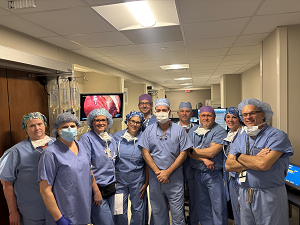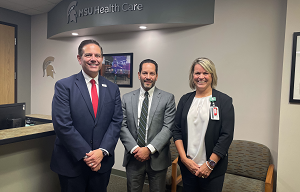Study: Sending Low-risk ER Chest Pain Patients Home Sooner Would Save Healthcare Thousands
FOR IMMEDIATE RELEASE
New Evaluation Accurately Predicts Safety of Release
DETROIT – A new evaluation to determine whether emergency room patients with chest pain can go home and follow up with their doctor proved 100% safe while shaving nearly a day off their visit and $6500 off their bill.
The “Henry Ford HEART Study” (Henry Ford Health), led by principal investigator and Henry Ford cardiologist Tiberio Frisoli, M.D., was published today in the American Heart Association’s “Circulation: Cardiovascular Quality and Outcome.” An accompanying American Heart Association editorial discusses "Achieving the Holy Grail of Emergency Department Evaluation for Chest Pain."
“This study shows you can send these low-risk chest pain patients home with a plan to be seen as outpatient by their doctor instead of the common practice of admitting them for stress testing,” Frisoli said. “Our study suggests you can safely save about 20 hours and about $6500 in charges per person. Multiply that by the number of people across the United States that go to the emergency room for chest pain – the #2 leading cause for ER visits - and the potential national healthcare savings of adopting this strategy would be monumental.”
The majority of patients who arrive at emergency rooms in the United States with chest pain are not having a heart attack, but rather pain due to musculoskeletal, gastrointestinal, pulmonary or other reasons. Nonetheless, ER physicians must maintain a high level of suspicion for heart attack or unstable angina as a cause of the patient’s chest pain. Heart attacks that are missed in the ER are associated with a significant number of deaths, and missed diagnoses are common grounds for legal action.
With that in mind, most ER physicians have a low threshold to rule out a heart attack, running multiple electrocardiograms and troponin blood tests that check for chemical signs of a heart attack, and very often order admission to the observation unit for stress testing. This stress testing is a large contributor to U.S. healthcare expenditure, which currently represents over 18% of the U.S. gross domestic product.
The randomized, prospective Henry Ford HEART Study enrolled 105 chest pain patients who arrived at emergency rooms at Henry Ford Hospital in Detroit or Henry Ford West Bloomfield Hospital between February 2014 and May 2015.
The patients’ troponin blood tests showed no chemical signs of a heart attack. And the patients were deemed low risk by a simple evaluation called the “HEART” score, an acronym for History, Electrocardiogram, Age, Risk factors and Troponin. The score combines the physician’s evaluation of the cardiac pain, the results of an ECG done in the ER, the person’s age, and the person’s traditional cardiac risk factors such as smoking, hypertension and diabetes.
To be enrolled, the patients’ symptoms had to be concerning enough that the doctors had intended to order stress testing.
Of those evaluated for safe enrollment in the trial, half were sent home to be seen by their physician, who then decided if further testing was warranted. The other half were admitted to the hospital for immediate stress testing.
The study found immediate discharge was associated with an average 20-hour shorter length of stay (6 hours 20 minutes versus 25 hours 51 minutes of total time in the hospital) and a $6500 reduction in total hospitalization charges ($3,058 vs $9,616). There also were no known deaths, heart attacks, or coronary artery stenting in either group at 30-day follow-up.
“This early discharge strategy for low-risk patients not only saves time and money, but most importantly it also seems to be safe, though larger trials will be needed to definitively prove this,” said Frisoli, who conducted the trial as a cardiology fellow, mentored by Henry Ford Hospital cardiologist James McCord, M.D., and emergency room physician Richard Nowak, M.D.
“There is a strong interest in both the emergency room and cardiology communities to develop tools to better risk stratify and guide management for chest pain patients,” Frisoli added. “This is an exciting and potentially practice-changing area of research.”
The Henry Ford HEART score is currently being used to help evaluate chest pain patients arriving at the emergency room at Henry Ford West Bloomfield Hospital and is pending at other Henry Ford Health System facilities. Frisoli said Henry Ford doctors anticipate being part of future larger studies to further prove the evaluation’s effectiveness.
MEDIA CONTACT:
Tammy Battaglia
Tammy.Battaglia@HFHS.org
248-881-0809 cell/text
.svg?iar=0&hash=F6049510E33E4E6D8196C26CCC0A64A4)

/hfh-logo-main--white.svg?iar=0&hash=ED491CBFADFB7670FAE94559C98D7798)








